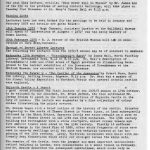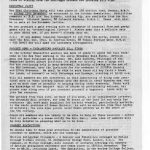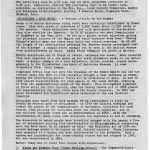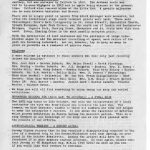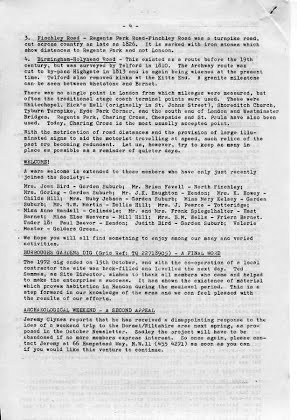
Page 1
STOP PRESS
See enclosed notice on “The Blue Plaques of Barnet”
Lecture Notes
A reminder
The next HADAS lecture, entitled “They Never Will be Missed” by Mr. James Lee pf the GLC on the problems of saving historic buildings, will take place on Tuesday 21st November at St. Mary’s Church Hall at 8.15 p.m.
Missing Links
Lecturers have now been booked for the meetings to be held in January and February 1973 and details are given below: –
16th January 1973 – Hugh Chapman, Assistant Curator at the Guildhall Museum, will speak of “Excavations at Aldgate – 1972” and the early history of Roman London.
20th February 1973 – R. J. Mercer of the British Museum will talk on excavations at Carn Brea, Cornwall.
Borough of Barnet Library Lectures
The following two lectures from the 1972/3 season may be of interest to members: –
Wedensday 15th November – “Tutankhamun’s Egypt” by James Hall, North Finchley Library, Ravensdale Road, N12 at 8.15 p.m. Mr Hall’s description of Tutankhamun’s tomb and other areas of Egypt provides an illuminating background to the current exhibition of the Treasures of Tutankhamun at the British Museum, now extended until 30th December.
Wednesday 7th February – “The castles of the Assassins by Robert Moss, Burnt Oak Library, Watling Avenue, Edgware, 8,15 p.m. Mr Moss was a member of the Alamut Valley expedition to Northern Persia when several notable castles were explored.
Baynards Castle – A Report
A good crown attended the first lecture of the 1972/3 season on 17th October, to be welcomed by our chairman, Mr. Brian Jarman, who then introduced Mr. Jeremy Haslam to speak on the recent excavations of Baynards Castle in the city of London. The lecture was augmented by a fine collection of coloured slides illustrating the points covered.
Mr. Haslam began with a brief outline of the history of the castle. Situated originally to the north of Thames Street in Norman times, on land subsequently utilised by the Black Friars, Baynards Castle was twice rebuilt on a site to the south of Thames Street in the 13th and 15th centuries. The 13th century building was rectangular with a stone courtyard, whilst corner towers and five smaller towers were added in the 15th century. Finally, it suffered severe damage in the Great Fire of 1666, after which fragments of stone were used in near-by dwellings until the site was entirely cleared at the beginning of the 19th century. Later, Victorian warehouses were built with extremely deep foundations which still cut straight across the whole site.
The remains of the castle, once the largest and most important non-ecclesiastical building in London, were rediscovered in a sewer trench in February, and Mr. Haslam described the subsequent excavations, which could only be carried out in between the Victorian warehouse foundations. A dock 25 to 30 feet wide existed to the west of the 13th century castle, and the western dock wall and mooring posts were found. This was filled in during the mid-15th century when the castle was extended and a wall built on the filling in the 16th century. As the castle was built on soft ground adjacent to the River Thames, which apparently consisted of a large percentage of horse manure, the foundations had to be very substantial. In fact the walls were built on elm piles 12 to 15 feet deep, overlaid with oak planks in rows of four. The building itself consisted either of well made chalk blocks or Kentish rag limestone, brought up river by barge. Alas Baynards Castle has now been completely destroyed by contractors building a new road across the site.
In answer to questions, Mr. Haslam stated that the largest collection of 15th and 16th century finds in the country were discovered in the dock area and a “robber trench” dig in connection with the dock wall, respectively. Amongst these were several thousand shoes. This material will probably go to the guildhall Museum. In conclusion, Mrs. Worby proposed a vote of thanks, and afterwards considerable interest was shown in the collection of finds on display from the Burroughs Gardens and Brockley Hill digs.
Page 2
Christmas Party
The HADAS Christmas Party will take place at 166 Station Road, Hendon, NW4 on Friday 15th December, as announced in the October Newsletter. Festivities commence at 7.30 p.m. and tickets costing 45p are available from the Hon Treasurer, Richard Deacon. These will also be on sale at the November lecture.
We are promised a gala evening with an abundance of seasonal fare and party games with an “archaeological flavour”! Please make this a definite date in your diary now, if you have not already done so.
P.S. If any member requires transport to and from the party, please contact the Hon. Sec. Mrs. Grafton Green who will make the necessary arrangements.
Project News – Cataloguing Brockley Hill Finds
In the October newsletter, mention was made of the plans to spend two full weekends in the New Year working on the early Brockley Hill finds. Details have now been finalised as follows: – Mr. John Enderby, Principal of the Hampstead Garden Suburb Institute (to whom the Society owes a large debt for his continuing help in these matters), is kindly allowing us the use of HGS Teahouse, near the Institute for the weekends of 27/28th January and 3/4th February. We shall be able to work there all day (with a break for lunch, or course!) on both Saturdays and Sundays starting at 10.00 a.m.
Will all members who are interested in this opportunity of doing some practical work on Roman pottery please note the dates in their diaries now, and give as much time as possible to helping during these weekends. Those with any knowledge of the subject will of course be particularly welcome, but please come along even if you consider yourself a beginner; there will be jobs for everyone.
The pottery from this site, as many of you know, is of considerable interest. The Brockley Hill potters. For some 60 years in the late 1st and early 2nd centuries AD, were main suppliers for certain vessels, particularly mortaria, to the whole province of Roman Britain. As well as material from this heyday of activity, the site also yields later Roman pottery up to the start of the 4th century.
Could all members who are likely to be able to help at these sessions – either full-time or part-time, please notify the Hon Sec; some idea of numbers will be very helpful in planning what is now to be done.
Current Exhibitions
We would like to draw your attention to two exhibitions of possible interest to members, which are now running:-
British Saltglazed Stoneware = A Seminar and Exhibition arranged by Morley College Ceramic Circle. The Seminar, at Morley College, will consist of lectures covering all aspects of British Saltglazed Stoneware and takes place on 18/19th November. The fee is £6.50, including lunch. The Exhibition, in Morley College Gallery, displays stoneware of British manufacturing centres, and documentary and archaeological evidence from London, running until 25th November. Admission free.
Local Maps and Views 17th to 19th century
Church Farm House Museum, Greyhound Hill, NW4 until 31st December, admission free. This exhibition, one of the activities planned for National Book Week 1972, comprises items drawn mainly from the Local History Collections of the Libraries Department. Maps of Middlesex and Hertfordshire, as well as local maps, show the growth of the area. Engravings, lithographs, and other illustrations of churches.
Page 3
Local History Conference
The London and Middlesex Archaeological Society are holding their 7th Local History Conference in the Livery Hall at the Guildhall, EC2 on Saturday 25th November. Mr. John Earl of the Historic Buildings Division of the Greater London Council will speak on “The urgent need to know more”. His talk will deal with the state of play in the field of conservation and he will be stressing the need to know our towns and localities better in order to care for them properly in the future. In addition there will be two short talks and exhibitions of publications, photographs and other materials of local societies, illustrating some of their recent work.
The doors will open at 1.30 p.m. and the main programme commences at 2.3o p.m. Admission, costing 35p (including tea) is by ticket only, available on application to the Hon Sec, Local History Committee, London and Middlesex Archaeological Society.
Milestones – Some Notes – a feature article by Ted Sammes
Markers to denote distances along roads were certainly established by Roman times. They were sited at distances of 1,000 Roman paces (1,620 yards or 1,400 metres). These milestones were not only guideposts or way-markers, they also extolled the Emperor. In 20 BC, Augustus was made Commissioner of Highways in the Rome area. He set up a gilded bronze milestone giving the principal centres of the Empire and their distances from Rome. During Trajan’s period, many new roads were built and others restored. By AD 200, the length of the description praising the Emperor vastly outweighed that of the mileage! A simple stone example can be seen in the British Museum from Llanfairfechan in Wales. Sixty three examples are known in Britain.
Modern milestones can be found on canals, railways and roads. More recently,. They have appeared in a new guise as one tenth kilometre posts on our motorways. A modern example of a road milestone, bullet scarred, stands incongruously in the Elizabethan courtyard at Maidstone Museum; it came originally from Kuala Lumpur.
Organised travel died out with the collapse of the Roman Empire and did not recover until 16th to 17th centuries brought a vast increase in trade. During the intervening period, travel was by pack-horse or mule. An Act of 1555 placed responsibility for road upkeep on the local Parish, removing it from he unsatisfactory hands of the Manor. This arrangement remained in force until the 19th century, when the County Courts Act of 1888 placed the responsibility for main roads with County Councils. In 1894, the Local Government Act transferred Paris authority to the new District Councils.
Turnpikes were apart from this system, being established at first as Trusts by Private Acts of Parliament. In 1773, the General Turnpike Act listed the powers of the Commissioners of Turnpikes, appointed for each County, thus placing the turnpikes under County Councils. One of the earliest turnpike roads was in Hertfordshire in 1663. With the introduction of these roads came mileposts and signposts to aid in charging.
The direction in which people travelled changed with the years; a fine set of milestones running from Hertfordshire to Buckinghamshire connecting with the Bath Road, is an example of this. The Mailcoach Act of 1784 required mileage marks to be placed on all letters carried. These distances were measured from London and were incorporated in the postmark. Such a system was inconvenient for cross country routes and was stopped in 1797, but re-introduced in 1801.
Barnet today has at least four routes of milestones:-
1. Along the Edgware Road (Roman Watling Street) – The Edgware-Kilburn Turnpike, 7 miles long, was opened in 1711, possibly at the instance of the Duke of Chandos, who built a house at Cannons a short distance north-east of Edgware. The present milestones are of cast iron, but there is one half-way up Brockley Hill, which is of stone. The site of the end of the turnpike is marked with a Blue Plaque.
2. Hampstead to Mill Hill – A rambling route from Hampstead to Mill Hill. These milestones are similar to the one at Brockley Hill, being of stone and rectangular in section. They cover a distance of 11 miles. Their presence was noted by Collinson in 1752 when he described them as newly erected. He mentioned the 10th stone opposite the sheep wash on Mill Hill Ridgeway.
Page 4
3. Finchley Road – Regents Park Road-Finchley Road was a turnpike road, cut across country as late as 1826. It is marked with iron stones which show distances to Regents Park, not London.
4. Birmingham-Holyhead Road- This existed as a route before the 19th century, but was surveyed by Telford in 1810. The Archway route was cut to bypass Highgate in 1813 and is again being widened at the present time. Telford also removed kinks at the Kitts End. A granite milestone can be seen between Whetstone and Barnet.
There was no single point of London from which mileages were measured, but often the traditional stagecoach terminal pints were used. These were Whitechapel, Hick’s Hall (originally in St. Johns Street), Shoreditch Church, Tyburn Turnpike, Hyde Park Corner and the south end of London and Westminster Bridges. Regents Park, Charing Cros, Cheapside and St. Pauls have also been used. Today, Charing Cross is the most usually accepted point.
With the metrication of road distances and the provision of large illuminated signs to aid the motorist travelling at speed, such relics of the past are becoming redundant. Let us, however, try to keep as many in place as possible as a reminder of quieter days.
Welcome
A warm welcome is extended to those members who have only recently joined the Society:- Mrs. Joan Bird – Garden Suburb; Mr. Brian Favell – North Finchley; Mrs. Goring – Garden Suburb; Mr. J. K. Haughton – Hendon; Mrs. K. Howey – Childs Hill; Mrs. Ruby Jobson – Garden Suburb; Miss Mary Kelsey – Garden Suburb; Mr. R. W. Martin – Dollis Hill; Mrs. J. Pearce – Totteridge; Miss Anned Randall – Colindale; Mr. And Mrs. Frank Spiegelhalter – East Barnet; Miss Else Weavers – Mill Hill; Mrs. B. M. Wells – Friern Barnet. Under 18: Paul Beevor – Hendon; Judith Bird – Garden Suburb; Valerie Master – Golders Green.
We hope you will all find something to enjoy among our many and varied activities.
Burroughs Gardens Dig (Grid Ref TQ22718905) – A final word
The 19772 dig ended on 15th October, and with the co-operation of a local contractor the site was back-filled and levelled the next day. Ted Sammes, as Site Director, wishes to thank all members who came and helped to make the enterprise a success. It has shown the existence of material which proves habitation in Hendon during the medieval period. This is a step forward in pour knowledge of the area and we can feel pleased with the results of our efforts.
Archaeological Weekend – A second appeal
Jeremy Clynes reports that he has received a disappointing response to the idea of a weekend trip to the Dorset/Wiltshire area next spring, as proposed in the October Newsletter. Sadly the project will have to be abandoned if no more members express interest. So once again, please contact Jeremy as soon as you can if you would like this venture to continue.

